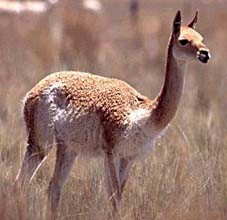|
|
|
Endangered Creatures |
|
 |
Turning
a vicuña's
coat
into commercially valuable cloth
on a sustainable basis
would not only help the local people,
it might also help secure
the future of this species
in the wild. |
|
How vicuñas live |
|
A member of the camel family, the vicuña is
closely
related to the llama and alpaca. The coat of the vicuña
is light brown above and off-white below, with a patch of longer
hair on the throat and chest, the latter serving to keep the
animal warm when resting on the ground. The head is relatively
small in comparison with body size, and the vicuña has small,
prominent ears and eyes. The neck is long. An adult vicuña is 4
to 6 feet long, stands 30 to 40 inches at the shoulder, and weighs
88 to 110 lb. It feeds on perennial bunch grasses,
tubers,
and
mosses.
Predators
include the puma and the Andean
fox.
The vicuña is a social animal. Territorial males maintain family groups
consisting of a number of adult females and their young;
non-breeding males live a solitary life or some may join other
males and form bachelor groups. The dominant male defends a
feeding and sleeping territory averaging 17 to 74 acres, which is
maintained throughout the year. Males rarely reach sexual maturity
before they are four years of age. Sexual maturity in the female
is reached in two to three years;
mating in March or April, she
produces one young after a gestation period of 330 to 350 days.
The young
nurses for up to ten
months and becomes independent between one and two years of age.
|
|
Where they live |
|
The vicuña is found in the Central Andes of South America, in Argentina,
Bolivia, Chile, and Peru. The majority of vicuñas are now on
protected reserves. In 1981 the population was estimated at
150,000 animals, of which some 98,000 occur in Peru.
The preferred habitat of this species is semi-arid
grasslands and plains at altitudes of 9,850 to 15,100 feet. Groups spend the day in
one feeding territory, then move to higher elevations at night to
sleep.
|
|
What is happening to their
habitat |
|
The vicuña is a
sought-after species
on account of its lustrous
wool--often said to be the finest quality in the world. Unlike the
other South American camelids, the llama and alpaca, the vicuña
was never domesticated and historically was not heavily used. The
Incas reserved the right to capture and
shear
wild vicuña for special rituals, and its wool was only used for
certain types of clothing. During this period, the Incas were
judicious in their use of vicuñas, but when the Spanish
overcame
the Inca people, all conservation measures were abandoned.
The vicuña population is thought to have been several million
individuals before it became the
target of hunters. By the 1500s, numbers had been reduced to less than 500,000; by 1965,
only 6,500 survived. At that point, conservation efforts were
initiated and protected reserves were
established for this species. Additional protection was provided by the
Convention of International Trade in Endangered Species of Wild
Fauna and Flora (CITES). These efforts were successful and
resulted in a population of 80,000 to 85,000 by the early 1980s.
Illegal hunting
is still a problem in parts of the animal's range,
particularly in Peru and Bolivia. Experiments have begun in Chile
and Peru, where viable populations now exist once again, to
capture, shear, and
release
wild animals. Turning a vicuña's coat into commercially valuable
cloth on a sustainable basis would not only help the local people,
it might also help secure the future of this species in the
wild.
|
|
Source:
Endangered Creatures Website
|
|
GLOSSARY |
|
coat:
hair or wool or fur covering the body of an animal
(piel)
closely related to: intimately related to (intimamente
ligada con)
tubers: fleshy underground roots (tubérculos)
mosses: tiny leafy-stemmed plants (musgos)
predators: any animal that lives by preying on other animals (predadores)
fox:
carnivorous mammal (zorro)
mating:
copulating (apareando,
copulando)
nurses:
feeds (se alimenta)
grasslands:
land
where grass or grasslike vegetation grows and is the
dominant form of plant life
(praderas, pampas) |
sought-after: greatly desired (perseguida)
on account of: due to, because of (a causa de, debido
a)
shear: cut the wool from (esquilar, cortar la lana)
overcame: wan the victory (ganaron, los vencieron)
target
of hunters:
purpose, objective of hunters (objetivo
de los cazadores)
to
hunt/hunted/hunted/hunting:
catch and kill animals
(cazar)
illegal hunting:
hunting declared illegal (caza
ilegal)
release: let free (liberar, dejar en libertad) |
|
|
|
|
 |
|
MAS "ECOLOGIA - VIDA SILVESTRE"
FORO
INICIO |
|